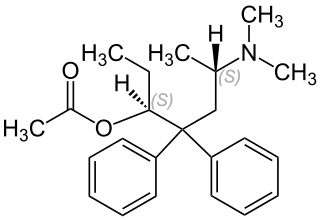
Methorphan comes in two isomeric forms, each with differing pharmacology and effects:

Properidine is an opioid, an analgesic, and the isopropyl analog of pethidine. Properidine is under international control and is listed in the United States under the Controlled Substances Act (1970) as a Schedule I substance. It is a narcotic, with an Administrative Controlled Substances Code Number (ACSCN) of 9644 and a 2 gramme annual aggregate manufacturing quota as of 2014. The salt in use is hydrochloride, with a free base conversion ratio of 0.88.

Benzylmorphine (Peronine) is a semi-synthetic opioid narcotic introduced to the international market in 1896 and that of the United States very shortly thereafter. It is much like codeine, containing a benzyl group attached to the morphine molecule just as the methyl group creates codeine and the ethyl group creates ethylmorphine or dionine. It is about 90% as strong as codeine by weight.

Hydroxypethidine (Bemidone) is an opioid analgesic that is an analogue of the more commonly used pethidine (meperidine). Hydroxypethidine is slightly more potent than meperidine as an analgesic, 1.5x meperidine in potency, and it also has NMDA antagonist properties like its close relative ketobemidone.

Normethadone, also known as desmethylmethadone or phenyldimazone, is a synthetic opioid analgesic and antitussive agent. Normethadone is listed under the Single Convention on Narcotic Drugs 1961 and is a Schedule I Narcotic controlled substance in the United States, with a DEA ACSCN of 9635 and an annual manufacturing quota of 2 grams. It has an effective span of action for about 14 days, and is 12 to 20 times stronger than morphine. The salts in use are the hydrobromide, hydrochloride (0.890), methyliodide (0.675), oxalate (0.766), picrate (0.563), and the 2,6-ditertbutylnapthalindisulphonate (0.480).

Levacetylmethadol (INN), levomethadyl acetate (USAN), OrLAAM or levo-α-acetylmethadol (LAAM) is a synthetic opioid similar in structure to methadone. It has a long duration of action due to its active metabolites.

Dimenoxadol (INN), or dimenoxadole (BAN), is an opioid analgesic which is a benzilic acid derivative, closely related to benactyzine. Further, the structure is similar to methadone and related compounds like dextropropoxyphene.

Dioxaphetyl butyrate is an opioid analgesic which is a diphenylacetic acid derivative, related to other open-chain opioid drugs such as dextropropoxyphene, levacetylmethadol (LAAM), lefetamine and dimenoxadol.

Proheptazine is an opioid analgesic related to pethidine. It was invented in the 1960s.

Clonitazene is an opioid analgesic of approximately three times the potency of morphine. It is related to etonitazene, an opioid of significantly higher potency. Clonitazene is not currently marketed. It is a controlled substance; in the United States it is a Schedule I Narcotic controlled substance with a DEA ACSCN of 9612 and an established manufacturing quota of 25 grams for 2022.

Dimepheptanol, also known as methadol or racemethadol, is a synthetic opioid analgesic related to methadone. It has similar effects to other opioids, including analgesia, sedation and euphoria, as well as side effects like itching, nausea and respiratory depression.

Acetylmethadol, also known as methadyl acetate, is a synthetic opioid analgesic. It is a racemic mixture of alphacetylmethadol (α-acetylmethadol) and betacetylmethadol (β-acetylmethadol), which are in turn racemic mixtures of levacetylmethadol and D-α-acetylmethadol and L-β-acetylmethadol and D-β-acetylmethadol, respectively. Hence, acetylmethadol has four possible optical isomers. All of these isomers have been shown to partially or fully substitute for the discriminative stimulus effects of heroin in rats, and thus it can be inferred that, in addition to LAAM which is used clinically as such, they are all likely to be active opioid analgesics in humans.

Alphamethadol (INN), or α-methadol, also known as alfametadol, is a synthetic opioid analgesic. It is an isomer of dimepheptanol (methadol), the other being betamethadol (β-methadol). Alphamethadol is composed of two isomers itself, L-α-methadol, and D-α-methadol. Both of alphamethadol's isomers bind to and activate the μ-opioid receptor and are active as opioid analgesics, similarly to those of alphacetylmethadol (α-acetylmethadol).

Betamethadol (INN), or β-methadol, also known as betametadol, is a synthetic opioid analgesic. It is an isomer of dimepheptanol (methadol), the other being alphamethadol (α-methadol). Betamethadol is composed of two isomers itself, L-β-methadol, and D-β-methadol. Based on structure-activity relationships it can be inferred that both isomers are likely to be active as opioid analgesics, similarly to those of betacetylmethadol (β-acetylmethadol).

Racemoramide, or simply moramide, is an opioid analgesic and a racemic mixture of the substances dextromoramide and levomoramide, two enantiomers of a chiral molecule.

Racemorphan, or morphanol, is the racemic mixture of the two stereoisomers of 17-methylmorphinan-3-ol, each with differing pharmacology and effects:

Alphacetylmethadol (INN), or α-acetylmethadol (AAM), is a synthetic opioid analgesic. Its levorotary enantiomer, levacetylmethadol, is an FDA-approved treatment for opioid addiction; however as of 2003 it is no longer used in the United States for this purpose. Alphacetylmethadol is very similar in structure to methadone, a widely prescribed treatment for opioid addiction. In the United States, it is a Schedule I controlled substance under the Controlled Substances Act, with an ACSCN of 9603 and a 2013 annual manufacturing quota of 2 grammes.
The major drug laws of India are the Narcotic Drugs and Psychotropic Substances Act (1985) and the Prevention of Illicit Trafficking in Narcotic Drugs and Psychotropic Substances Act (1988).

Noracymethadol (INN) is a synthetic opioid analgesic related to methadone that was never marketed. In a clinical trial of postpartum patients it was reported to produce analgesia comparable to that of morphine but with less nausea, dizziness, and drowsiness. Other side effects included salivation, ataxia, and respiratory depression that was reversible by naloxone. Similarly to many of its analogues, noracymethadol is a Schedule I controlled substance in the United States with an ACSCN of 9633 and 2013 annual manufacturing quota of 12 grammes. and is also controlled internationally under the United Nations Single Convention on Narcotic Drugs of 1961. The salts known are the gluconate and hydrochloride (0.903).

Methade, or 6-(dimethylamino)-4,4-diphenylheptane, is the parent compound of the methadone and methadol series of opioid analgesics:



















